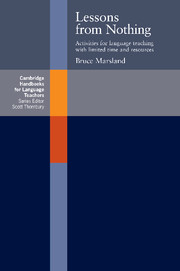Book contents
- Frontmatter
- Contents
- Acknowledgements
- Introduction
- 1 Activities using no resources
- 2 Activities using pens and paper only
- 3 Activities using pens and paper only
- 4 Activities using blackboard, pens and paper
- 5 Activities using other resources
- References
- Bibliography for limited–resource situations
- Index according to language activity type
4 - Activities using blackboard, pens and paper
Published online by Cambridge University Press: 04 May 2010
- Frontmatter
- Contents
- Acknowledgements
- Introduction
- 1 Activities using no resources
- 2 Activities using pens and paper only
- 3 Activities using pens and paper only
- 4 Activities using blackboard, pens and paper
- 5 Activities using other resources
- References
- Bibliography for limited–resource situations
- Index according to language activity type
Summary
Dictogloss
Language Listening comprehension
Level Elementary upwards
Age Any
This is a well established dictation-based activity which helps to develop conscious listening skills in addition to an awareness of phrase and sentence structures.
Procedure
Choose a sentence suitable for the level of the class. This might be a sentence from a coursebook, but if so, make sure it is one which is not yet familiar to your students. An example sentence is given below. Tell the class that you will read this sentence to them once only. They should write down the key words as you read. You should not have to repeat the sentence, but with a large class you might like to read it once at the front of the room and once at the back. Students then work individually to try to recreate your sentence.
After a few minutes, elect a scribe. The class then works together to remember the whole sentence, which the scribe writes on the blackboard. When students have run out of ideas, read the original sentence one more time, and encourage them to get their version on the blackboard completely accurate. With the example overleaf, if you give the class the words ‘Narcissus’ and ‘Oreads’ on the board, these will act as anchors to help them with the order of the rest of the text.
Variation
Use a short paragraph or a whole short text, and ask students to get as close to the original as possible.
- Type
- Chapter
- Information
- Lessons from NothingActivities for Language Teaching with Limited Time and Resources, pp. 71 - 75Publisher: Cambridge University PressPrint publication year: 1998



